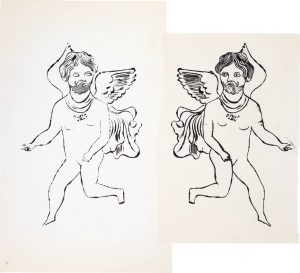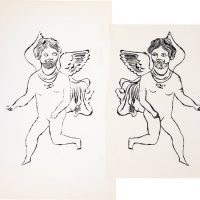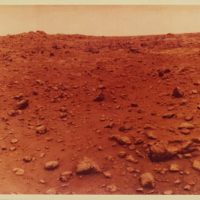Category: London
October 11, 2012 — October 14, 2012
For the inaugural Frieze Masters art fair in London we will be showing the third part of our exhibition trilogy “From Silverpoint to Silver Screen”, a special one-man exhibition of Andy Warhol drawings from the 1950s.
These outstanding drawings are from the personal collection of one of the 20th century’s most significant artists, presented to the public for the first time, 50 years after their creation. We are afforded a unique and comprehensive insight into Andy Warhol’s work in the 10 years following his departure from the grey city of Pittsburgh, during the period of his artistic emancipation in New York. This is an opportunity to get to know him as the grand draftsman that he was.
Excerpt from the catalogue text by Sydney Picasso:
…
And his thirst bore him through, every image was seized, and while moments of repose produced slow and steady line drawings, time passing drove him to tracing, blotting, repro, collage; in this series we observe an impressive roster of techniques. The theme is not idleness, it is haste, an irrepressible drive to get on with it, to record and thus “live” this new life he has embraced, which will turn out to be tragically short. His “Walk on the Wild Side”: thirty odd years of total immersion, and I believe revelry, in a world he had only glimpsed before arriving on the streets of New York. “I was nobody, I came from nowhere,” he repeated. And as he was willing to literally try anything, we witness here such odd subjects as children in groups, facial studies, and the infamous child shooting up “America’s nightmare,” a mercenary drawing for a CBS series of recordings based on childhood addiction: Andy won the “prize” for art direction for this project and the image became iconified in what would become the first of his many record covers. This initiated yet another chapter in his endless forays into media, to the point that certain later images would portray the Daily News heading directly incorporated in the painting, such as in Daily News, 1962, portraying Eddie Fisher and Liz Taylor’s breakup.
Special Preview: 9 Oct, 3 – 8 pm
Professional View: 10 Oct, 11 am – 7 pm
Exhibition: 11 – 13 Oct, 12 – 7 pm
14 Oct, 12 – 6 pm
Regent’s Park, London
Booth F13

September 7, 2012 – September 29, 2012
“There shall be wings! If the accomplishment be not for me, ‘tis for some other. The spirit cannot die; and man, who shall know all and shall have wings…”
Leonardo da Vinci
Daniel Blau presents an extraordinary exhibition of rare NASA photographs and photographic collages of Mars. The collages are composed of vintage silver gelatin prints and are unique works of art.
Until the Mariner 4 probe’s successful fly-by in July 1965, Mars had only been seen through terrestrial telescopes. All of a sudden photographs were transmitted to earth that were of such clarity that we could almost touch the surface of the planet. Viking 1 continued where the Mariner missions left off, and delivered wonderfully detailed photographs of this mysterious planet, named after the Roman God of War and long subject to speculations regarding the possibility of alien life.
What began as a race to put a man on the moon progressed further and further into space, spurred on by limitless ambition and curiosity. These photographs evoke an incomparable time in history when technology was developing at an incredible rate and the impossible became not only possible, but visible for the entire world to see.
July 6, 2012 – July 28, 2012
With NOW! we present an exhibition of vintage 20th century press prints.
We focus the exhibition on events, on stop-the-press snapshots that not only document but define history. There is no motion, only moments in quick succession, and in an age of media saturation we are quick to look at and dismiss newspaper stories and photographic coverage of events, not because images aren’t interesting or important, but because there are too many of them.
The prints in the show are vintage, meaning they were printed at the time when the photograph was originally taken. Most prints are analogue wire- or radio-transmitted images. The resulting hardcopy prints were used for the creation of magazines or newspapers, and were later stored in news archives. Many of the prints have ink stamps and news clippings on the back, and some display airbrushing or crop marks on the front. They have themselves collected history, and over time have borne witness to vast global change and upheaval.
These prints are thus testimony to the events of the past and reliquaries for our changing beliefs. They are valuable due to their status as historical documents, but everyone should be able to own a part of history and their affordability reflects this ideal.
Please join us for the opening of this exhibition on Thursday 5th July from 6 – 9 pm at 51 Hoxton Square.
June 1, 2012 – June 30, 2012
Daniel Blau Ltd. is pleased to present a unique collection of nineteenth century cyanotypes by Georges Poulet, in the first exhibition of its kind in the UK.
French engineer Georges Poulet’s (1848 – 1936) photographs of railway construction in Argentina convey a sense of the pioneering spirit characteristic of the nineteenth century. These cyanotypes depart from customary notions of documentary photography, taking the viewer on an intensely atmospheric journey through the largely unspoiled Argentina of the late nineteenth century. They also reveal a desire to record technological progress in an artistic way. The mysterious blues produced by the cyanotype process create a special ambience, while the captions written elegantly in red ink at the bottom of each photo provide an element of narrative and of contrast.
Scientist Sir John Frederick Herschel invented the cyanotype (more commonly known as the blueprint) in the early days of photography. Engineers and architects used it to reproduce technical drawings, maps and so forth; but artists also employed the technique and its influence is evident in their work.
Poulet employs the advantages of the cyanotype medium: its ability to reproduce reality, and the blue that is an integral part of it. Blue, of course, has a metaphorical dimension, symbolising longing for far-off places. In one of those distant regions we encounter the subject of Poulet’s series of cyanotypes: full of yearning, he shows us the railway in Argentina as in a dream, flooded in a melancholy blue.
Please join us for the opening of this exhibition on Thursday 31st May, 2012 from 6 – 9 pm at 51 Hoxton Square.
Abridged text from “Aurora Argentina”, an illustrated publication accompanying the exhibition and containing a complete catalogue of Poulet’s Argentinian cyanotypes.
April 20, 2012 – May 25, 2012
This April Daniel Blau Ltd. is very pleased to present a selection of images that question the role of identity and scale the vintage photographic oeuvre. Since photography’s beginning the question of representation and truth has been widely discussed, complicated by the medium’s insistence on “realism”. In a photograph grandeur is minimised, compacted, and fixed like Baltic amber pulled from the sea, ensnaring the maker’s “vision” in reduced format.
Moving along into the 20th century, photographic technology advanced to such a degree that the operator of the camera no longer even needed to be present – imagine the first view of Earth from Space encrypted in video and produced in a Californian Lab. We can think back to the origins of photography and to Daguerre with his famous dioramas – large-scale theatrical backdrops that intended to represent more closely the feeling of being pulled into a vision of the mountains and streams of ancient Greece. So what happens when we reduce the idea of optics to a singular two-dimensional object? Can we identify our place within the frame or must we also compress, reduce, and rend the photograph to fit our own scale within the universe?
We live in a new era of rapid technological advancements built upon major achievements such as the infamous atomic bomb testings in the Pacific atolls. Why should our understanding of our place within the frame not also advance?
Please join us for our opening on Thursday 19th April from 6 – 9 pm at 51 Hoxton Square, London N1 6PB.
February 17, 2012 – April 13, 2012
“If you are not willing to see more than is visible, you won’t see anything.”
Ruth Bernhard
What we see here are unique paper negatives from the 1850’s by some of the greatest old master photographers. They are the true originals, created by the light reflecting off the photographed subject. For their beauty, zeitgeist, rarity and provenance they rank amongst the greatest treasures of photography.
The paper negative had its heyday for a brief period in the early days of photography until c. 1860. Because the negative is the plate from which a multitude of positive prints can be made, it normally remained in the photographer’s possession during his lifetime. Only later would it enter into public collections by will of the photo-grapher or the family’s donation. It is rare to find negatives by famous artists such as Le Secq, Nègre, de Beaucorps or de Clercq in private hands.
A negative can be so much more evocative than a positive print. We realize from the blurred movement of the clock’s hand on the picture of the Palazzo Vecchio that it took 3 minutes of exposure time to take the photo, long enough to empty the square of all the people moving about. Their movements made them invisible to the camera. Only the building remains in its static existence with the guard’s rifles leaning against the wall.
Like a printing plate, the photographic negative has long been regarded as a stage in a working process. Surrealism and other lessons in art have taught us how to look at the more abstract pictures of the world. We have since begun to appreciate the photographic paper negative with its saturated, ominous dark against the ethereal pale as a work of art in its own mysterious beauty!
December 14, 2011 – December 22, 2011, 2012
Please join us for a rummage through a collection of enigmatic and vernacular photographs put together over the span of 13 years. From wall to table, all photographs, at your perusal, will be available for sale from 80 English pounds upwards. For this special Christmas event we have extended the gallery hours to include Sunday the 18th December, 11am to 6pm.
October 11, 2011 – December 12, 2011, 2012
On the occasion of Gerhard Richter’s major retrospective at the Tate Modern this October, Daniel Blau Ltd. will be housing a parallel exhibition entitled “Benjamin Katz: Gerhard Richter – Atlas Exchanged”.The result of a friendship spanning more than four decades between Richter and Katz, this selection of 80 photographs is taken from the photographer’s vintage archive and includes portraits taken from the 1980s onwards at a variety of locations, including Richter in his studio.
Not confined to the canvas, Richter’s dialogue with photography, prints, and other media present an unequivocal insight into the post-war artist finding his subject matter through whichever media is at hand. The importance of Richter’s body of work “Atlas” is now well documented; serving to highlight the artist’s life’s work and processes through a spiraling amalgamation of imagery culled from his archive. In direct relation to this, we present Katz’s consistent documentation of the spirit of Richter living amongst his work: Katz fashions his photographs in such a way as not to intrude, but, rather to be part of an exchange of ideas found deep within Richter’s sprawling oeuvre.
September 1, 2011 – October 6, 2011
An exhibition of vintage, anonymous, vernacular and spirit photography, also including works by Fratelli Alinari, Cecil Beaton, René Barthélemy, Paul Berthier, Emil Cadoo, Louis Joseph Deflube, Arthur Conan Doyle, JH Engstrom, Walker Evans, Jean-Baptiste Frenet, Michael Grieve, Bill Jacobsen, Fritz Lang, Rut Blees Luxemburg, Charles Marville, Tina Modotti, Floris Neusüss, Arnold Newman, Diane Pernet, Leni Riefenstahl, Henri Sauvaire, Jeffrey Silverthorne, Edmund Teske, U.S. Army Picture Corps, Louis Vignes et al.
“They are moving because of their phantom condition; every act they execute may be their last; there is not a face that is not on the verge of dissolving like a face in a dream.”
Jorge Luis Borges
We are pleased to present a unique set of images that embody a theme particularly relevant to current artistic and cultural practice: that of the haunted, the blurred and the dissolved. To exemplify these themes this exhibition will feature vintage prints as well as more recent explorations in photography and its often-dissolute processes. In homage to the alchemy and chemistry of photography, this show will illustrate fire, smoke, the spirit, the x-ray, blur and motion, decay and the photogram. Like a series of dark objects and entities trapped behind the framing of glass, the gallery space becomes a chapel to the haunted history of the photographic medium.
July 7, 2011 – August 10, 2011
Daniel Blau Ltd. is pleased to present Neal Fox’s latest project Beware of the God. Fox’s drawings depict a phantasmagoric journey through the detritus and mythology of pop culture. From a life-long obsession with the tales of his dead grandfather, a World War II bomber pilot, writer and hell raiser, his large-scale drawings have developed into increasingly layered celebrations of the debauched and iconoclastic characters whose ideas have helped shape our collective consciousness.
Fox’s latest project takes many of the recurring subjects of his drawings and portrays them through the medium of the stained glass window. As traditional church windows show the iconography of saints, through representations of events in their lives, instruments of martyrdom and iconic motifs, Fox plays with the symbolism of each character’s cult of personality; Albert Hoffman takes a psychedelic bicycle ride above the LSD molecule, J G Ballard dissects the world, surrounded by 20th Century imagery and the eroticism of the car crash, and Johnny Cash holds his inner demon in chains after a religious experience in Nickerjack cave. One quality in particular binds these characters and the others together; a refusal to conform and conviction in their own ideology.
Working with traditional methods at the renowned Franz Mayer of Munich manufacturer, Fox is producing a set of twelve 2.5 metre high stained-glass windows; exhibited in a single room – an alternative church of alternative saints.







 +49 89 29 73 42
+49 89 29 73 42